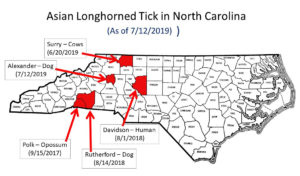NEW – Asian Longhorned Tick Publication Available
go.ncsu.edu/readext?627542
en Español / em Português
El inglés es el idioma de control de esta página. En la medida en que haya algún conflicto entre la traducción al inglés y la traducción, el inglés prevalece.
Al hacer clic en el enlace de traducción se activa un servicio de traducción gratuito para convertir la página al español. Al igual que con cualquier traducción por Internet, la conversión no es sensible al contexto y puede que no traduzca el texto en su significado original. NC State Extension no garantiza la exactitud del texto traducido. Por favor, tenga en cuenta que algunas aplicaciones y/o servicios pueden no funcionar como se espera cuando se traducen.
Português
Inglês é o idioma de controle desta página. Na medida que haja algum conflito entre o texto original em Inglês e a tradução, o Inglês prevalece.
Ao clicar no link de tradução, um serviço gratuito de tradução será ativado para converter a página para o Português. Como em qualquer tradução pela internet, a conversão não é sensivel ao contexto e pode não ocorrer a tradução para o significado orginal. O serviço de Extensão da Carolina do Norte (NC State Extension) não garante a exatidão do texto traduzido. Por favor, observe que algumas funções ou serviços podem não funcionar como esperado após a tradução.
English
English is the controlling language of this page. To the extent there is any conflict between the English text and the translation, English controls.
Clicking on the translation link activates a free translation service to convert the page to Spanish. As with any Internet translation, the conversion is not context-sensitive and may not translate the text to its original meaning. NC State Extension does not guarantee the accuracy of the translated text. Please note that some applications and/or services may not function as expected when translated.
Collapse ▲]We have had requests for information about the Asian longhorned tick (Haemaphysalis longicornis) which is an invasive species that was initially reported as found on sheep in New Jersey in 2017. However, the USDA-APHIS found a specimen in a sample of ticks that had been collected in West Virginia in 2010 and initiallly misidentified as lonestar ticks. As of October 1, 2019, the Asian longhorned tick has been reported in twelve states (AR, CT, DE, KY, MD, NJ, NY, NC, PA, TN, VA, and WV). In North Carolina, this tick has been found in five counties during the last three years although each case involved one animal or one site. We now have a publication about the tick’s biology available for you to use at:



